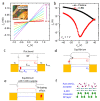High Photoresponse Black Phosphorus TFTs Capping with Transparent Hexagonal Boron Nitride
- PMID: 34940453
- PMCID: PMC8705758
- DOI: 10.3390/membranes11120952
High Photoresponse Black Phosphorus TFTs Capping with Transparent Hexagonal Boron Nitride
Abstract
Black phosphorus (BP), a single elemental two-dimensional (2D) material with a sizable band gap, meets several critical material requirements in the development of future nanoelectronic applications. This work reports the ambipolar characteristics of few-layer BP, induced using 2D transparent hexagonal boron nitride (h-BN) capping. The 2D h-BN capping have several advantages over conventional Al2O3 capping in flexible and transparent 2D device applications. The h-BN capping technique was used to achieve an electron mobility in the BP devices of 73 cm2V-1s-1, thereby demonstrating n-type behavior. The ambipolar BP devices exhibited ultrafast photodetector behavior with a very high photoresponsivity of 1980 mA/W over the ultraviolet (UV), visible, and infrared (IR) spectral ranges. The h-BN capping process offers a feasible approach to fabricating n-type behavior BP semiconductors and high photoresponse BP photodetectors.
Keywords: black phosphorus (BP); hexagonal boron nitride (h-BN); n-type; photodetector; thin film transistors (TFTs).
Conflict of interest statement
The authors declare no conflict of interest.
Figures



References
-
- Koenig S.P., Doganov R.A., Schmidt H., Neto A.H.C., Ozyilmaz B. Electric field effect in ultrathin black phosphorus. Appl. Phys. Lett. 2014;104:103106. doi: 10.1063/1.4868132. - DOI
LinkOut - more resources
Full Text Sources
Miscellaneous

